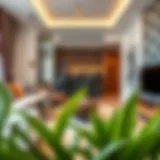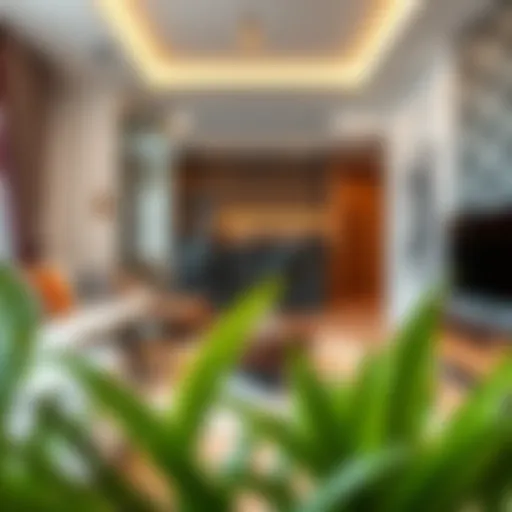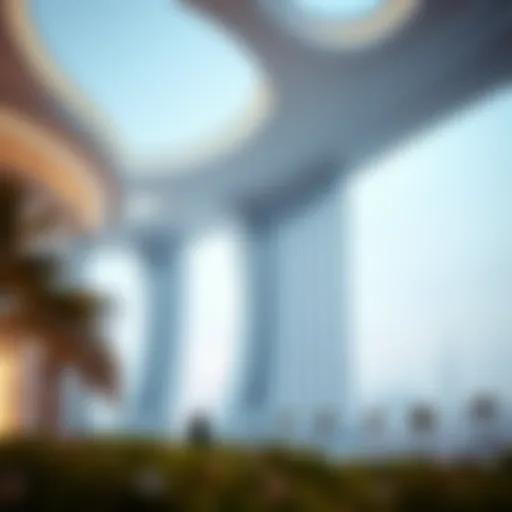Majlis Design: Blending Culture and Modern Living


Intro
In exploring Majlis design in contemporary homes, one finds a unique blend of functionality and cultural essence. A Majlis, traditionally a gathering place, serves as a vital element in Middle Eastern homes, particularly within the Arabian Peninsula. It's more than just a room; it embodies hospitality, familial ties, and cultural heritage. As society evolves, so too does the Majlis, adapting to modern aesthetics while retaining its essential warmth and charm.
This guide dives into the various facets of Majlis design, from its historical roots to practical considerations and modern adaptations. We will highlight key principles affecting design choices, explore color and material selections, and examine how contemporary influences shape this classic space. This gives homeowners and designers the tools necessary to create welcoming Majlis areas that resonate deeply with cultural significance and modern living needs.
By the time you finish reading, you will grasp the various elements involved in creating a Majlis that is not only functional but also a true reflection of heritage and contemporary life.
Preface to Majlis Design
Understanding Majlis design is essential for anyone interested in creating harmonious living spaces that honor tradition while accommodating modern needs. A Majlis, often found in homes across the Arabian Peninsula, serves as a gathering space where families and guests come together to share moments—be it at a joyful celebration or a quiet evening of conversation. The relevance of Majlis design extends beyond mere aesthetics; it encapsulates a cultural story that binds communities and showcases values of hospitality and respect.
This section aims to delve into the significance of Majlis design by exploring its historical context and cultural importance, while recognizing its functional aspects. Homeowners and designers alike stand to benefit from a deeper understanding of how to effectively incorporate Majlis spaces into contemporary living environments.
Historical Context
The origins of the Majlis can be traced back centuries, woven deeply into the fabric of Arab heritage. Initially, these gathering spaces were modest, often characterized by simple seating arrangements with floor cushions known as diwans that invited comfort in familiarity. Historically, Majlis spaces were typically outside, under large shade-providing tents or structures, where families would come together to escape the heat of the desert sun.
As time marched on, the design of the Majlis began to evolve, reflecting the influences of trade, migration, and cultural exchange. From the intricate tile work seen in Oman to the elegant wooden carvings present in the traditional Majlis of Saudi Arabia, the physical space began to signify wealth and status. It became a stage for opulence when hosting dignitaries, showcasing the host's prestige and their adherence to the cultural practice of hospitality.
Today, this historical context underpins how the Majlis is perceived and designed in modern homes. The blend of tradition with modern aesthetics can be seen in the way materials, colors, and architectural styles are chosen to honor the past while innovating for the future.
Cultural Significance
More than just a physical space, the Majlis carries immense cultural weight. It is a symbol of community, a venue for building relationships. Within these walls, stories are shared, advice is exchanged, and bonds are strengthened, fostering a sense of belonging that parallels the warmth of family. Particular emphasis is placed on the concept of hospitality, a core value in Arab culture that is embodied in the Majlis environment. Guests are treated with utmost respect, often welcomed with coffee and dates, a ritual that reinforces social ties and marks the significance of personal connections.
Moreover, Majlis designs contribute to continued cultural identity in an ever-globalizing world. As modern architecture and styling infiltrate traditional norms, maintaining the essence of the Majlis allows for a dialogue between old and new. Designers find themselves challenged yet inspired to reinterpret these spaces—layering textures, colors, and layouts in ways that respect tradition while embracing innovation.
In summary, understanding the historical context and cultural significance of Majlis design is vital for creating spaces that not only pay homage to a rich heritage but also meet the functional needs of contemporary life. This nuanced comprehension fosters a deeper appreciation for the interplay between art, culture, and functionality in designing inviting Majlis spaces.
Key Elements of Majlis Design
Designing a Majlis involves more than just aesthetics; it’s about creating an inviting space that embodies cultural significance while serving its functional purpose. The core elements—spatial arrangement, furniture selection, textiles, and lighting—play an essential role in establishing an environment that encourages social interaction and family ties. Each component contributes not only to the beauty of the Majlis but also to its functionality.
Spatial Arrangement
The spatial layout in a Majlis is fundamental in dictating how the space will be experienced. Traditionally, Majlis spaces feature a distinct, open layout. This openness encourages interaction and fosters a sense of community. The placement of seating must consider the flow of movement and accessibility. It’s not just about how it looks; it’s also about how people interact within it. For example, arranging seating in a circular formation can promote discussion and ensure no one feels excluded.
When planning the layout, a few things need to be kept in mind:
- Gathering Ease: Ensure there's room for guests to move without feeling cramped.
- Privacy Considerations: While openness is key, some areas might require subtle ways to maintain intimacy, which can be achieved through strategic placement of plants or furniture.
- Cultural Practices: The arrangement can also reflect cultural norms, such as the need for a designated space for refreshments.
Furniture Selection
Selecting the right furniture goes beyond visual appeal—it needs to be practical, comfortable, and culturally relevant. Traditional Majlis furniture typically includes low seating options such as floor cushions and settees, promoting a relaxed atmosphere. These choices encourage people to sit together comfortably, fostering a feeling of closeness. Modern interpretations might feature sleek couches or modular pieces, balancing comfort with contemporary style.
Key considerations for furniture include:
- Material Durability: Choose furniture made from strong materials that can withstand heavy use.
- Aesthetic Consistency: Keep the style coherent; mix and match pieces that complement each other rather than clash.
- Cultural Heritage: Include items that reflect local craftsmanship or traditional styles, creating a sense of connection to the heritage.
Textiles and Fabrics
Textiles contribute significantly to the ambiance of a Majlis. They can transform a space by bringing in colors, textures, and patterns that resonate with cultural themes. Fabrics for upholstery, curtains, and decorative cushions should be chosen carefully to add warmth and comfort. Traditional textiles often present intricate designs that tell a story, while modern fabrics might take a minimalist approach, focusing on texture more than patterns.
Considerations for textiles include:
- Layering for Depth: Combine different fabrics and textures to create a layered look, increasing interest without overwhelming the senses.
- Cultural Patterns: Incorporate traditional designs to pay homage to local culture.
- Maintenance: Opt for fabrics that are easy to clean, maintaining the space's beauty over time.
Lighting Considerations
Lighting plays a pivotal role in setting the mood and functionality of a Majlis. Natural light is often preferred as it creates an inviting atmosphere, but the integration of artificial lighting adds flexibility. Layered lighting—combining ambient, task, and accent lighting—can help achieve a welcoming environment suitable for various activities, from formal gatherings to casual conversations.
Some tips on lighting include:
- Dimmers for Control: Utilizing dimmer switches can allow for adjusting the ambiance according to the occasion.
- Decorative Fixtures: Choose lighting that acts as a statement piece while also being functional.
- Natural Sources: Maximize the use of windows and doors to let in ample light during the day, while also considering how to keep the space well-lit during evening gatherings.
A well-designed Majlis should reflect the harmony between traditional values and modern needs, balancing aesthetics with functionality.
Understanding these key elements empowers homeowners and designers to create Majlis spaces that are not only beautiful but also resonate with cultural significance and serve their social purpose effectively.
Majlis Styles and Variations
Majlis design varies significantly across different regions and cultures, reflecting the unique histories and tastes of the communities that create them. Understanding Majlis Styles and Variations is crucial for those aiming to integrate these spaces into modern homes. It helps in appreciating the rich tapestry of design elements, ensuring that each Majlis reflects not just an aesthetic preference but also a deep cultural identity.
Traditional Majlis


The Traditional Majlis embodies the essence of heritage in design. Characterized by intricate woodwork, ornate textiles, and authentic artifacts, this style is a celebration of cultural roots. Traditional Majlis often features low, plush seating arranged in a way that encourages conversation. The walls may be adorned with tapestries or calligraphy, providing a visual narrative that speaks to a rich cultural history. Large carpets are common, softening the space while also adding a layer of warmth.
“In traditional settings, a Majlis is more than just a room; it’s a gathering spot where stories are shared and histories are honored.”
Key Features of Traditional Majlis:
- Seating Arrangements: Low cushions or carpets encourage relaxed gatherings
- Decorative Elements: Lamps, pottery, and wall hangings rich in history
- Color Palette: Earthy tones combined with vibrant hues to stimulate a warm ambiance
The incorporation of traditional elements offers a sense of nostalgia. However, it is vital to maintain balance by ensuring comfort alongside authenticity. Homeowners should also consider functionality to avoid creating spaces that are just visually appealing but impractical for modern use.
Modern Majlis Interpretations
As society evolves, so do the interpretations of Majlis design. The Modern Majlis integrates contemporary elements while still respecting traditional roots. Here, simplicity often takes center stage. Clean lines, minimalistic furniture, and understated elegance define this style. Unlike traditional formats, these Majlis may include modular seating or multifunctional furniture, allowing for a more fluid use of space.
Characteristics of Modern Majlis:
- Furniture Selection: Sleeker designs and versatile pieces for flexibility
- Color Schemes: Monochromatic themes or bold accent colors that lend a modern flair
- Open Layouts: Often connected to other living spaces, enhancing spatial flow
This style is particularly well-suited for urban dwellings, where maximizing space is key. The modern approach retains the welcoming atmosphere associated with Majlis while catering to the needs of a fast-paced lifestyle.
Hybrid Approaches
Hybrid Approaches to Majlis design represent the fusion of traditional and modern influences. This style is about striking a delicate balance, merging the warmth and authenticity of tradition with the sleek functionality of modern design.
Elements of Hybrid Majlis:
- Eclectic Furnishings: Combining vintage pieces with contemporary items
- Mixed Textiles: Layering different fabrics can create visual interest
- Artistic Displays: Showcasing local artwork alongside modern decor
Adopting a hybrid model allows homeowners to create a personalized space that resonates personally. It reflects a family’s unique journey and preferences, while also respecting the cultural essence embedded in traditional design.
The versatility found in hybrid styles can lead to innovative spaces that are more engaging and inviting for social gatherings.
In summary, exploring Majlis styles and variations opens a door to a wealth of design options, allowing for a profound connection between aesthetics and cultural significance. Whether leaning towards traditional, modern, or hybrid styles, it’s crucial to approach each choice with an understanding of its impact on the overall environment and purpose of the space.
Color Schemes in Majlis Design
In the intricate world of Majlis design, color schemes play a pivotal role in creating an inviting and culturally rich environment. The right colors not only enhance the aesthetic appeal but also evoke emotions, set the mood, and create a sense of harmony within the space. Whether it’s for a gathering of family and friends or a formal meeting, the hues chosen for the Majlis can speak volumes about the cultural significance and personal taste of the homeowner.
Color schemes in Majlis design must reflect both traditional aesthetics and modern sensibilities. From vibrant and bold colors to soft and muted shades, each choice can transform the ambiance of the room. Therefore, understanding the implications of color selection is essential for creating a space that is not only functional but also resonates culturally and socially.
Traditional Color Palettes
Traditional Majlis often features a rich palette that draws from the natural colors found in the environment, reflecting the heritage and history of the region. Deep reds, earthy browns, muted golds, and striking greens are commonly utilized to create depth and warmth in the space.
- Red and Gold: This combination often signifies hospitality and generosity, aligning with the Islamic cultural values of welcoming guests.
- Earthy Tones: These colors help to invoke a feeling of tranquility and connection to the earth, enhancing the natural materials often found in traditional designs.
- Incorporation of Patterns: The use of geometric patterns in color can add an extra layer of complexity, presenting a visual play that mesmerizes without overwhelming the senses.
These colors are usually complemented by intricate textiles and decor pieces that might include traditional handicrafts or intricate tile work. This ensures that every corner of the Majlis tells a story, echoing the grandeur and warmth of cultural roots.
Modern Trends and Innovations
As times change, so do preferences, and modern Majlis designs have adapted to include innovative color schemes that introduce contemporary aesthetics while maintaining cultural significance. The modern approach often favors a cleaner, more minimalist palette that strikes a balance between tradition and innovation.
- Soft Neutrals: Colors like beige, soft gray, and pastel hues can create a serene atmosphere, conducive to conversation and relaxation. These shades are notorious for allowing flexibility with décor changes.
- Bold Accents: Even in a neutral setup, pops of bold colors—like teal, mustard, or deep blue—can make for an eye-catching contrast, often used in cushions, art pieces, or feature walls.
- Technological Influence: Utilizing smart lighting systems allows homeowners to change hues based on mood or occasion, adapting the Majlis to various social setups seamlessly.
By merging traditional warmth with sleek modernity, designers are enhancing the functionality of the Majlis while catering to today’s evolving social dynamics. This duality not only enrichens the aesthetics but also enlivens the social fabric of how the Majlis is experienced.
"A Majlis is not just a space; it’s an experience colorfully embodied in design and function."
In summary, the color schemes in Majlis design encapsulate the essence of cultural identity and personal expression. From traditional palettes that honor the past to modern innovations that embrace the future, each choice plays a crucial role in the overall effectiveness of the space. Designing a Majlis with thoughtful color selections promises a space that is not only beautiful but also deeply connected to the cultural narrative it represents.
Materials Commonly Used in Majlis Spaces
In the field of Majlis design, materials play a crucial role, not merely as aesthetic choices but as carriers of cultural significance. The right materials enhance both the visual appeal and functional aspects of these spaces. Homeowners and designers alike must consider how materials influence the ambiance, comfort, and traditions that are woven into the very fabric of a Majlis.
Natural Materials
Natural materials are often at the forefront of Majlis design, offering a sense of authenticity and connection to nature. These materials typically include wood, stone, and clay, all of which have been utilized in traditional architecture for centuries.
- Wood: Commonly used in ceiling beams, furniture, and wall panels, wood adds warmth and richness to a Majlis. Varieties like teak or cedar not only bring in a rustic charm but also have durability and longevity.
- Stone: Elements such as marble or limestone can create a sleek and elegant look, suitable for flooring or wall accents. Apart from beauty, stone is revered for its cooling properties, keeping the space comfortable in warmer climates.
- Clay: Often used in decorative items or ceramic furnishings, clay embodies a handcrafted appeal. These pieces not only serve practical purposes but also tell stories through their artful designs, often reflecting the local craftsmanship and history.
Using natural materials can help create a harmonious setting that encourages tranquility and conversation. As the saying goes, "what's good for the earth is good for the heart"—and this sentiment rings true in Majlis design.
Synthetic Alternatives
While traditional materials dominate, synthetic alternatives have gained traction in modern Majlis design, offering practical solutions that can be both stylish and cost-effective. These materials often boast enhanced durability and ease of maintenance, making them appealing for busy households.
- Synthetic Fibers: Used in upholstery and textiles, synthetic materials like polyester can mimic the luxurious feel of natural fabrics while being resistant to stains and fading. This can be especially useful in areas of high foot traffic.
- Engineered Stone: Materials such as quartz or porcelain are options for surfaces or tiles. These alternatives provide a uniform look and are available in a variety of colors and patterns, allowing for creative expression without the porous nature of natural stone.
- Resin: Commonly found in modern furniture or decor items, resin can be molded into various shapes and finishes. This flexibility allows for innovative designs that can balance contemporary aesthetics with traditional forms.


While it may lack the organic allure of natural materials, synthetic alternatives can still offer a compelling narrative in a Majlis setting, especially when designed thoughtfully to blend with other elements.
"In design, materiality is the soul of the space, echoing both tradition and innovation."
Ultimately, the choice of materials—whether drawing from natural origins or relying on synthetic innovations—shapes the character of a Majlis. The right selection not only enhances the physical environment but also supports an interaction with cultural narratives. Designing these spaces requires a careful balance of tradition and modernity, reflecting the tastes and desires of the residents.
Incorporating Technology in Majlis Design
The integration of technology into Majlis design opens up a realm of possibilities, marrying tradition with modernity. As homes evolve into smart living spaces, the Majlis – a cultural cornerstone – is not excluded from this transformation. Technology enhances functionality while preserving the Majlis's integral social and cultural roles. Consideration for these tech elements can greatly impact how a Majlis space serves both family and guests.
Smart Home Features
In today's world, smart home technology is more than just a trend; it's becoming a norm in home design. The Majlis can benefit significantly from smart features which contribute to comfort and convenience.
- Smart Lighting: Adjustable lighting fixtures can change the ambiance at the push of a button. Dim lights can create a cozy atmosphere for gatherings, while bright settings can be used for more dynamic interaction during events.
- Temperature Control: Smart thermostats ensure the Majlis remains comfortable, adapting to the needs of the occupants. This is particularly vital in regions where temperature fluctuations can be extreme.
- Automated Window Treatments: Blinds or curtains that open and close with a voice command or programmable schedule can offer privacy and manage natural light.
- Voice Assistants: Devices like Amazon Echo or Google Home can facilitate hands-free control of lighting, music, and temperature, making social interactions smoother.
Smart home features are critical not just for convenience but also for elevating the overall experience of the Majlis, allowing for effortless hosting and engagement.
Multimedia Integration
The modern Majlis is also stepping into the age of multimedia, integrating technology for entertainment and connectivity. This move caters to a diverse range of interactions, from leisurely movie nights to vibrant social gatherings.
- Audio Systems: High-quality sound systems can elevate the experience during family gatherings, providing a backdrop of music or engaging audio for video presentations.
- Visual Displays: Wall-mounted screens for presentations or streaming can be hidden when not in use, maintaining the traditional aesthetic while offering modern features. Imagine a Saturday night where you can transform your Majlis into a mini cinema, complete with popcorn and comfy cushions.
- Wi-Fi Solutions: A robust wireless system ensures that guests can stay connected without interruptions. Whether for personal devices or business discussions, seamless connectivity is vital in today’s interconnected world.
The thoughtful integration of multimedia can foster connectivity and create an inviting atmosphere, ensuring the Majlis remains a prime spot for socializing.
Effective use of technology in Majlis design doesn’t just enhance functionality; it transforms the space into a hub of modern interaction, respecting the social fabric of tradition.
By incorporating elements of smart living and multimedia, the Majlis can serve as both a haven of cultural significance and a beacon of modern convenience. The careful balance of these technologies elevates the traditional role of the Majlis while ensuring that it meets the demands of contemporary life.
Functional Aspects of Majlis
The Majlis is more than just a design feature; it's a vital component of cultural expression and practical living. Understanding the functional aspects of Majlis design is crucial for homeowners, investors, and designers alike. In many ways, the Majlis serves as the heart of a home, tailored to foster social engagements and family unity. The emphasis placed on this space transcends mere aesthetics; it becomes a stage for social interactions and family narratives, thus enriching the overall living experience.
Social Gathering Space
A Majlis often acts as the epicenter for social gatherings, blending hospitality with cultural tradition. When you step into a well-designed Majlis, it should feel inviting, almost pulling you in like a warm embrace. This space is tailored for interactions, festivity, and communal sharing. Wide seating arrangements and comfortable cushions allow for prolonged conversations, while a well-thought-out layout promotes flow, preventing awkward spacial dead zones.
In planning a Majlis, it’s important to consider elements like:
- Seating Capacity: The arrangement should accommodate both small and large gatherings. An adaptable setup allows hosts to quickly modify configurations based on the social occasion.
- Ambiance: The mood of the space can greatly influence social dynamics. Carefully selected lighting and textiles often create an inviting atmosphere.
- Access: A direct path to refreshments or snacks encourages guests to mingle freely, reducing the formality often associated with gatherings.
Effective Majlis designs focus on comfort and accessibility, ensuring every guest feels at home. With the right touch, the Majlis helps in building connections, reinforcing social ties, and celebrating cultural heritages. The care put into its design reflects the value placed on guests, demonstrating hospitality in every corner.
Family Interaction Zone
Every family needs a corner where connections thrive, and in many homes, this corner is the Majlis. It's a sanctuary for families to share experiences, be it through casual conversations, meals, or family activities. The thoughtful design of the Majlis can enhance interactions and create a nurturing environment that promotes understanding and cohesion among family members.
When designing a Majlis as a family interaction zone, consider:
- Zoning: The area can offer dedicated spaces for different activities, like reading nooks for quiet times and expansive areas for board games or family discussions.
- Children-Friendly Features: The incorporation of durable materials is essential, especially in homes with children. Seating that is easy to clean and safe measures ensure everyone, even the little ones, can enjoy the space without worry.
- Nature Elements: Incorporating natural light or indoor plants can foster a more inviting and serene setting, encouraging families to spend quality time together.
Majlis spaces designated for family use often encourage deeper conversations, reflection, and shared experiences. They can transform households into nurturing environments, encouraging family traditions and memories that last a lifetime.
"A well-designed Majlis not only welcomes guests but also nurtures family bonds, uniting generations under one roof."
For further reading and insights into Majlis designs and cultural significance, consider visiting Wikipedia or Britannica.
These resources expand on the cultural narratives that enrich the design approaches for Majlis and highlight innovative designs adopted in contemporary settings.
Design Challenges and Solutions
Designing a Majlis can often be a double-edged sword. On one side, it carries cultural and personal significance, inviting a sense of belonging and tradition. On the other, there are practical hurdles that can impact the realization of a beautiful space. It’s essential to address these design challenges and develop solutions that maintain the essence of a Majlis while adapting to modern living needs.
Space Constraints
Space limitations are one of the foremost challenges faced when crafting a Majlis area. Many homes are designed with various functions in mind, and the Majlis might not always have a designated area.
- Creating Flow: It’s vital to ensure that movement within the dwelling is fluid. Often, the Majlis needs to be integrated into the main living space. This can be tricky. To tackle this, consider using versatile furniture that can be reconfigured, such as modular sofas that can adapt to different gatherings.
- Function Over Furniture: Choose low-profile furniture that doesn't dominate the space visually but still provides comfort. For instance, large floor cushions can serve as both seats and conversation starters without crowding.
- Use of Mirrors: Incorporating mirrors strategically can help create an illusion of depth. This reflects not only light but also the vibrancy of the space, making it feel less claustrophobic.
Addressing space effectively also hinges on being mindful about decorative accents. Opting for wall-mounted decor rather than standing pieces frees up floor space significantly.
Cultural Appropriateness
Every detail in a Majlis doesn’t merely hold an aesthetic value but also speaks to cultural identity. It's crucial that the design honors the traditional elements that define its essence.


- Authentic Artistry: Select artworks and decor items that tell a story or have cultural relevance. This could include traditional calligraphy, local handicrafts, or even family heirlooms. These elements are not just embellishments; they are crucial in preserving heritage and instilling a sense of pride.
- Inviting Atmosphere: The design must accommodate the cultural practice of hospitality. Arrangements that facilitate conversation and gatherings are key, perhaps a circular seating arrangement that makes everyone feel included. Flat seating around a central table encourages interaction and won’t feel stiff or formal.
- Design Elements with Meaning: Color choices should not only be visually appealing but also culturally resonant. For instance, earthy tones can evoke warmth and tradition, while vibrant colors can symbolize festivity. Understanding these implications can help create spaces that are not just inviting, but deeply respectful of the cultures they represent.
Incorporating these design aspects not only ameliorates challenges related to space but also elevates the Majlis into a beautifully functional, culturally rich hub of family and friends.
"Great design is about solving problems while honoring the story behind every space."
For more insights into Majlis design practices, check Wikipedia and Britannica.
By tackling both space and cultural considerations, homeowners can create a Majlis that radiates warmth, connection, and beauty.
Case Studies of Successful Majlis Designs
Exploring case studies of successful Majlis designs brings to light the practical applications of design elements in real-world settings. These instances serve as both inspiration and a guide for homeowners and designers aiming to balance aesthetics with functionality. When approaching the Majlis design, understanding how different elements have been utilized successfully in various environments can help in creating a space that meets modern needs while respecting traditional values.
The critical benefits of examining these case studies include:
- Practical Insights: Each design offers a practical perspective on which layouts and materials resonate best with cultural expectations and social functions.
- Cultural Resonance: Successful designs often reflect the local traditions and practices, ensuring the space embodies the essence of a connected community.
- Innovative Solutions: Analyzing how challenges were overcome in space constraints or cultural appropriateness reveals potential solutions that can be adapted.
Contemporary Homes
In contemporary settings, Majlis designs often integrate modern aesthetics while preserving the core functionalities associated with the traditional gathering space. One striking example is a spacious villa located in Dubai that exemplifies this balance. This home engages with open-plan layouts, melding the Majlis with living areas seamlessly. The use of floor-to-ceiling windows floods the room with natural light, enhancing the warmth and inviting atmosphere.
Key features of this design include:
- Neutral Color Palette: Soft whites and beiges dominate the walls, allowing the colorful textiles and artworks to take center stage.
- Updated Furnishings: The furniture is a mix of traditional elements, like low seating, blended with contemporary pieces that provide comfort and style.
- Technological Integration: This home seamlessly incorporates smart home technology, allowing for control of lighting and temperature while maintaining the tranquil ambience typical of a Majlis.
This contemporary Majlis design not only serves as a gathering spot but also reflects the homeowner's personality and lifestyle, showcasing how tradition can evolve without losing essence.
Traditional Residences
In a more traditional setting, a historic home in Oman demonstrates the power of Majlis as a cultural and social cornerstone. This residence emphasizes artisanship, detailed craftsmanship, and a layout that promotes community interaction. The Majlis here is characterized by intricately carved wooden ceilings, ornate plasterwork, and traditionally patterned cushions that invite guests to sit and indulge in conversation.
Distinct aspects of this traditional Majlis include:
- Cultural Artifacts: Decor elements like antique coffee pots and handwoven rugs provide a glimpse into the local heritage, enriching the experience for visitors.
- Distinctive Layout: The design encourages circular arrangements, facilitating conversation and ensuring everyone feels included in discussions.
- Natural Materials: Use of local stone and wood not only connects the space to the environment but also reflects responsible resource use indicative of traditional practices.
Old or new, the essence of the Majlis remains centered on creating a welcoming atmosphere that bridges generations and strengthens community ties.
Emphasizing the integration of culture within the design not only beautifies spaces but also strengthens the bonds within the community it serves.
By studying these case studies, investors, realtors, and potential buyers can gather valuable insights into how to approach Majlis design in a way that resonates with both tradition and modern needs.
Future Trends in Majlis Design
The world of Majlis design is ever-evolving, reflecting shifts in cultural values and modern tastes. As we move forward, understanding future trends is paramount for anyone involved in home design. These trends not only shape aesthetic preferences but also address practical needs that arise in contemporary living. In this section, we will dive into two critical aspects that future Majlis designs will consider: sustainability practices and evolving social dynamics.
Sustainability Practices
Ensuring that our homes respect the environment is no longer a mere preference; it has become a necessity. Sustainability practices in Majlis design can take several forms, emphasizing energy efficiency and eco-conscious materials. Here’s what one should look at:
- Eco-friendly Materials: Designers are increasingly opting for sustainable wood sourced from responsibly managed forests. Bamboo, a rapidly renewable material, is gaining traction for its aesthetic appeal and minimal environmental footprint.
- Natural Lighting: Where possible, maximizing natural light minimizes the need for artificial illumination. Expansive windows not only save energy but also connect the indoor Majlis with the outdoor spaces, creating a sense of tranquility.
- Water Conservation Features: Utilizing water-efficient fixtures and systems can dramatically reduce water consumption. Integrating such elements into the Majlis adds a modern touch while respecting traditional values of hospitality.
Sustainability is about striking a balance. It's about creating beautiful spaces without compromising on the health of our planet. As we adopt these practices, the visual appeal and functionality of the Majlis can remain strong, echoing the respect for culture alongside modern lifestyle needs.
Evolving Social Dynamics
The way families and communities interact is shifting rapidly in today’s digital age. The evolving social dynamics are important to consider in Majlis design. Traditional gatherings might have become less frequent, but the need for connection remains. Here are some thoughts on this:
- Hybrid Spaces: Modern Majlis designs are embracing flexible layouts that allow for various functionalities. This might mean incorporating cozy lounge areas that double as tech zones or game spaces for the family, turning the room into a focal point of interaction.
- Inclusivity: Designs that cater to diverse gatherings are essential. Incorporating varying seating arrangements, from floor cushions to elegant chairs, allows everyone to feel included and comfortable, thus promoting communal interactions.
- Technological Integration: As families become more tech-oriented, integrating smart technology becomes a part of the social fabric. From voice-controlled lighting to video call capabilities, the Majlis can evolve into a hub where people connect, regardless of distance.
Adapting to evolving social dynamics emphasizes the necessity to create spaces that are not just beautiful but serve functional purposes for modern lives. A well-designed Majlis will cater not only to the aesthetic needs but also to the emotional and relational aspects of family and community life.
"Majlis design is as much about connection as it is about aesthetics; the two should go hand in hand in creating a space that resonates with our heritage while embracing modern life."
These future trends point towards a more integrated approach in Majlis design—one that combines cultural essence with forward-thinking practices.
Epilogue
In wrapping up our exploration of Majlis design, it’s vital to recognize its multifaceted role within contemporary homes. This unique space draws from deep-rooted traditions while embracing modern functionality. The design of a Majlis is more than just an aesthetic choice; it is a tangible expression of cultural values and social cohesion.
Summative Observations
Reflecting on the insights garnered throughout this article, we can distill a few key takeaways regarding Majlis design:
- Cultural Engagement: Incorporating a Majlis creates a bridge between generations, honoring a lineage while fostering dialogue among family and friends.
- Functional Versatility: The Majlis can transform to accommodate gatherings, quiet moments, or even work-from-home setups. Flexibility in the design enhances its appeal.
- Aesthetic Harmony: Each design element, from colors to materials, work in concert to evoke a sense of warmth and welcome, supporting the purpose of the Majlis.
"A well-designed Majlis transcends mere decoration; it becomes a living emblem of shared moments and community ties."
Final Thoughts on Majlis Integration
Investment in a thoughtful Majlis design can yield dividends in social interactions and community building, enhancing familial bonds in an age when genuine connection is often fleeting. Furthermore, as urban life continues to evolve, the adaptability of the Majlis will surely resonate with diverse audiences.
Ultimately, this guide serves as an invitation to embrace the art of Majlis design, a canvas where culture, functionality, and beauty converge.











